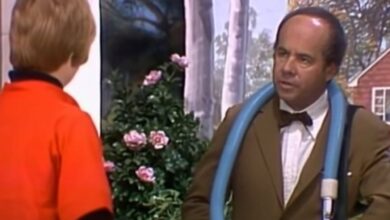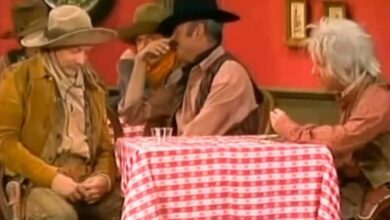Johnny Horton’s “North to Alaska” Merges Country, Folk, and Frontier Lore into a Chart-Topping, Era-Defining Anthem (1960)
When Johnny Horton released “North to Alaska” in August 1960, the song did more than provide a musical backdrop to a major Hollywood film—it captured the spirit of the American frontier in a way that resonated with a broad audience. Blending folk storytelling with upbeat country instrumentation, it became an instant hit. It topped Billboard’s Country Singles chart and crossed into the pop charts, peaking at No. 4 on the Billboard Hot 100. More than just a soundtrack piece, “North to Alaska” struck a chord with postwar America, symbolizing ambition, adventure, and the mythic gold rush spirit.
Johnny Horton had a penchant for turning American history into chart gold. Born in Los Angeles in 1925 but raised in Texas and Louisiana, Horton embodied the cross-state currents of Southern music. Though he began in honky-tonk country, he gravitated toward a more narrative-driven style that blurred the lines between folk ballads and mainstream country. Known for his articulate diction, boyish charm, and energetic delivery, Horton carved out a unique niche with what fans later dubbed “saga songs.” This approach allowed him to stand out in a crowded field dominated by heartbreak ballads and dance tunes.
The inspiration behind “North to Alaska” came from the film of the same name, a 1960 Western comedy-adventure starring John Wayne and set during the Nome Gold Rush. The film’s producers specifically requested Horton to compose and perform the title track—a testament to his growing reputation for historical storytelling through song. Working with frequent collaborator Tillman Franks and songwriter Mike Phillips, Horton quickly crafted a song that summarized the film’s plot while appealing to listeners unfamiliar with the movie. The resulting track blended historical references with romantic themes, adding wide appeal.
Recording took place in Nashville, and the production reflected the city’s evolving sound. The instrumentation leaned heavily on steel guitar and upright bass, but what set “North to Alaska” apart was its unusual structure. It begins with a spoken-word introduction that sets the scene, followed by a catchy chorus that acts as both refrain and historical summary. Horton’s clear, confident vocal delivery brought energy to every syllable, while the band played with an infectious rhythm that mirrored the pace of a dog-sled journey north.
Upon release, the song’s reception was swift and enthusiastic. In addition to reaching No. 1 on the country charts, it stayed on the Billboard Hot 100 for 15 weeks. It was Horton’s biggest crossover success after “The Battle of New Orleans,” and it became one of the few country tracks at the time to gain traction in both American and international markets. The song also boosted interest in the film itself, creating a synergy between music and cinema that presaged later soundtrack-driven hits in country and pop alike.
“North to Alaska” also played a crucial role in redefining the country genre’s thematic boundaries. Until then, most mainstream country songs centered on personal heartbreak, domestic life, or religious themes. Horton’s song—like others in his catalog—expanded the genre’s narrative range, opening doors for artists to explore historical and cinematic storytelling. It was no longer just about tears in your beer; now, it could be about panning for gold and staking claims on frozen frontiers.
For Horton himself, the song cemented his position as country music’s most compelling storyteller. It gave him not only a massive commercial hit but also a legacy tied to Americana itself. Horton began receiving invitations for film-related promotions, national television appearances, and high-profile concert tours. It further positioned him as a crossover figure, one capable of translating rustic themes into mass-market entertainment.
The influence of “North to Alaska” on other artists was immediate and widespread. Story songs gained renewed prominence, and artists such as Marty Robbins, Red Sovine, and even Elvis Presley would incorporate more overt narratives into their work. Horton had shown that history could be catchy—and that audiences were hungry for songs with a sense of place and purpose.
Other artists did attempt to cover the song, but few renditions matched the energy and clarity of Horton’s original. In later decades, the song would be performed by folk and bluegrass musicians at historical festivals and reenactments, further embedding it into America’s cultural memory. Some even saw it as a patriotic anthem, a musical homage to the last great American frontier.
Tragically, Horton would not live to see the full impact of “North to Alaska.” Just two months after the song’s release, he died in a car accident at age 35. The sudden loss of such a promising artist cast a long shadow over the country music world. Many fans saw the song as Horton’s farewell—a triumphant, optimistic track that captured his strengths as a performer and left a lasting impression.
Despite his brief career, “North to Alaska” has endured across generations. It remains a staple on classic country radio, appears in countless Americana playlists, and continues to find new fans through retrospectives and film reruns. Its spirited rhythm and vivid lyrics still transport listeners to the frozen wilds of the north, just as they did in 1960.
More than a novelty or soundtrack tune, “North to Alaska” helped shape how country music could engage with history, geography, and adventure. Its success laid the groundwork for future genre-bending hits and reminded the industry that songs could both entertain and educate. Horton may have taken listeners on a journey to the Yukon, but the real destination was the future of country storytelling.
In the years following his death, Horton’s contributions were formally recognized by institutions like the Country Music Hall of Fame and various songwriter organizations. “North to Alaska” remains one of the cornerstones of his posthumous acclaim, often cited in retrospectives about the evolution of narrative country music.
Ultimately, “North to Alaska” stands as a landmark in both Johnny Horton’s career and the history of country music itself. It captured a national mood, offered a fresh sound, and inspired future generations of artists to push the boundaries of what a country song could be. More than sixty years later, its call to adventure and spirit of determination continue to resonate.





